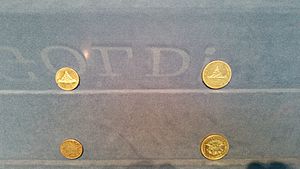Denver Mint facts for kids
|
Denver Mint
|
|
|
U.S. Historic district
Contributing property |
|

The Denver Mint
|
|
| Location | West Colfax Avenue and Delaware Street, Denver, Colorado |
|---|---|
| Built | 1897 |
| Architect | James Knox Taylor |
| Architectural style | Late 19th and 20th century revivals |
| Part of | Civic Center Historic District (ID74002348) |
| NRHP reference No. | 72000270 |
Quick facts for kids Significant dates |
|
| Added to NRHP | February 1, 1972 |
| Designated CP | February 27, 1974 |
The Denver Mint is a special place in Denver, Colorado. It's a branch of the United States Mint, which is where the U.S. government makes its money. The Denver Mint started making coins on February 1, 1906. It's still working today, making coins for everyday use, special coin sets, and commemorative coins (coins made to remember important events or people).
Coins made at the Denver Mint have a small D mint mark on them. This helps people know where the coin was made. The Denver Mint is actually the biggest producer of coins in the whole world!
Contents
History of the Denver Mint
Early Days: Clark, Gruber & Co.

Before the official Denver Mint, there was a company called Clark, Gruber & Co. This was during the Pikes Peak Gold Rush. Miners found a lot of gold dust in the area. Shipping this gold dust all the way back east was expensive and risky.
So, in 1860, Austin M. Clark, Milton E. Clark, and Emanuel Henry Gruber decided to open their own private mint in Denver. They started making gold coins from the gold dust brought by miners. Their mint opened on July 25, 1860. They could make "fifteen or twenty coins a minute."
Their first coins were $10 gold pieces. They had a picture of Pikes Peak on one side with "Pikes Peak Gold" and "Denver" written on it. The other side had an American Eagle and their company name, "Clark, Gruber & Co." Later, they also made $20, $5, and $2.50 gold coins.
In almost three years, they made over $594,000 worth of gold coins. They also bought a lot of raw gold. In April 1863, the U.S. Treasury bought their building and equipment. Clark, Gruber & Co. then became a bank.
Becoming a U.S. Assay Office
The United States government decided to open a mint in Denver. This was made official by a law passed by Congress on April 21, 1862. The U.S. Mint in Denver started its operations in late 1863. It used the same building that Clark, Gruber and Company had used. The government bought it for $25,000.
However, at first, the Denver plant didn't make coins like Clark, Gruber & Co. had. Instead, it was an Assay Office. An Assay Office checks the purity and weight of metals. Miners would bring their gold and nuggets there. The office would melt the gold, check how pure it was, and then stamp it into gold bars. These bars were then given back to the miners.
One reason given for not making coins right away was trouble with Native American tribes along the routes. This was during the American Civil War, and there were concerns about safety.
Most of the gold came from rich areas where gold was found in streams. Later, miners started finding gold and silver in veins deep underground. By 1859, the value of gold and silver brought to the Assay Office was more than $5.6 million each year. In its early years, the Denver Assay Office was one of the most important buildings in the city.
The Modern Mint is Built
As more gold was discovered, the U.S. Treasury needed to expand its operations. In 1872, some businessmen set up a company called Denver Smelting and Refining Works. This company processed ore into metal bars. The Denver Mint then checked and stamped these bars.
There was a new plan to make the Denver facility a full branch mint, able to make gold and silver coins. A new location for the mint was bought on April 22, 1896. It was at West Colfax and Delaware streets and cost about $60,000. Construction on the new building began in 1897.
It took some time to get enough money to finish and equip the new building. The Assay Office finally moved into the new building on September 1, 1904. Coinage operations, meaning the actual making of coins, finally began on February 1, 1906. This officially made the Denver facility a Branch Mint.
Before the new coin-making machines were installed, they were first shown at the St. Louis Exposition in 1904. Silver coins were made in Denver for the first time in 1906. In its first year, the Denver Mint produced 167 million coins! This included $20, $10, and $5 gold coins, along with different silver coins.
The Denver Mint building was added to the National Register of Historic Places in 1972. It was also included as an important part of the Civic Center Historic District in 1974.
Today, the Denver Mint continues to be very busy. It makes special commemorative coins, coin dies (the tools used to stamp coins), and uncirculated coin sets. It can produce more than 50 million coins every single day and has about 350 employees.
See also
 In Spanish: Casa de Moneda de Denver para niños
In Spanish: Casa de Moneda de Denver para niños


